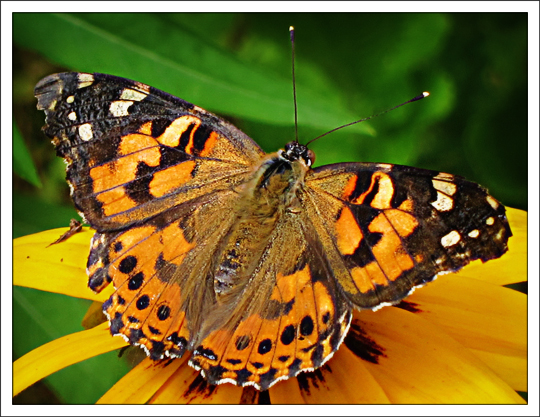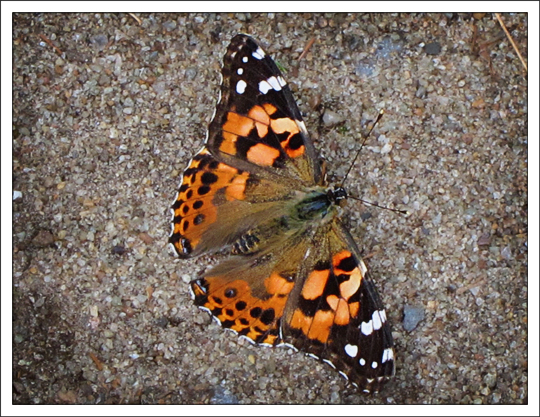Butterflies of the Adirondack Mountains:
Painted Lady (Vanessa cardui)
 Butterflies of the Adirondacks: Painted Lady (Vanessa cardui) in the Paul Smiths VIC Butterfly House (19 July 2012)
Butterflies of the Adirondacks: Painted Lady (Vanessa cardui) in the Paul Smiths VIC Butterfly House (19 July 2012)
| This page is no longer being updated. For an updated version of this material, see: Painted Lady (Vanessa cardui). |
The Painted Lady (Vanessa cardui) is a medium-sized orange and black butterfly that may be seen in the Adirondack Mountains of upstate New York in July and August. It is a member of the Brushfoot family. [1] It is also known as the Thistle Butterfly [2] [3] -- a reference to the caterpillars' food preference -- and also as the Cosmopolitan because it is said to be the most widely distributed butterfly in the world. [4] [5] [6] [7] The term carduus is Latin for thistle -- another reference to the caterpillar's food plant. [8] [9]
From above, this butterfly is orange brown,[10] darker at the wing base, with a bold black median band forming a semi-circle. The hind wing has a submarginal row of five small black spots. From below, the Painted Lady is predominantly rose-pink with an olive, black, brown, and gray pattern and four small submarginal blue eyespots. [11] [12] The wing span of the Painted Lady is 2.2 inches. [13]
The Painted Lady is quite similar in appearance to the American Lady. The Painted Lady has more pointed wings. The eyespots on the upperside of the hind wing lack the blue centers seen on the American Lady. [14] Also, the American Lady often has a small white spot in the orange cell by the upper wing margin, which helps distinguish it from the Painted Lady. [15] In addition,the row of submarginal dots on the hind wing are often connected by a smeary line in the American Lady, while those on the hind wing of the Painted Lady are not connected. [16] The underside of the American Lady has two large blue eye spots near the outer margin on an olive field on the hind wing. The Painted Lady, by contrast, has four smallish eye-spots. [17]
 Butterflies of the Adirondack Mountains: Painted Lady in the Paul Smiths VIC Butterfly House (25 August 2012)
Butterflies of the Adirondack Mountains: Painted Lady in the Paul Smiths VIC Butterfly House (25 August 2012)
Male Painted Ladies perch and patrol during the afternoon for receptive females, usually on bare ground in open area. Female Painted Lady butterflies lay single eggs on host plant leaves. [18] Host plants include thistles, hollyhocks, mallow, and various legumes. Adult Painted Ladies consume nectar from plants such as asters, cosmos, blazing star, ironweed, and joe-pye weed, milkweed, and red clover, [19]
From the ecological standpoint, the Painted Lady butterfly is a generalist, [20] highly tolerant of different habitats. [21] [22] It can be found in heavily wooded areas, as well as open areas, such as waste areas, roadsides, farmers' fields, and areas where thistles abound. [23] .[24] The Painted Lady has a very wide range, covering all continents except Australia and Antarctica.
 Butterflies of the Adirondacks: Painted Lady (Vanessa cardui) in the Paul Smiths VIC Butterfly House (19 July 2012)
Butterflies of the Adirondacks: Painted Lady (Vanessa cardui) in the Paul Smiths VIC Butterfly House (19 July 2012)
On the North American continent, the Painted Lady overwinters in warm southern areas or in Mexico, and then migrates and temporarily colonizes the US and Canada south of the Arctic. [25] [26] [27] Sources conflict as to whether these butterflies make a return southbound migration. Some sources suggest that the Painted Ladies do not make a distinct southward migration in the fall, although some diffuse southern movements have been reported. [28] Others indicate that the Painted Lady makes a less conspicuous return migration, although not as large as springtime flights. [29] Most sources agree that many of the immigrants die when temperatures fall in the North, to be replenished the following year by new migrants. [30] The number of immigrants reportedly fluctuates greatly from one year to the next. [31] [32] [33] Next to the Monarch butterfly, the Painted Lady is North America's most conspicuous migrant.[34]
In 2012, the Painted Lady was seen in the Paul Smiths VIC Native Species Butterfly House from mid July to early September. [35]
References
- Susan Grimm Hanley. Interpretive Naturalist, Paul Smith's College Native Species Butterfly House. Species Logbooks.
- Butterflies and Moths of North American. Species Profiles. Sighting records: 7/19/12; 7/19/12; 8/20/12; 8/20/12; 8/25/12; 8/25/12; 8/25/12; 9/1/12
- Government of Canada. Canadian Biodiversity Information Facility. SpeciesBank.
- Massachusetts Butterfly Club. Massachusetts Butterfly Species List.
- ENature. Field Guides.
- Iowa State University. Department of Entomology. BugGuide.
- University of Michigan. Animal Diversity Web.
- Ross A. Layberry, Peter W. Hall, and J. Donald Lafontaine. The Butterflies of Canada (University of Toronto Press, 1998), pp. 205-206, Plate 17.
- National Audubon Society. Field Guide to Butterflies (New York: Alfred A. Knopf, 1981), pp. 625-626.
- Jim P. Brock and Kenn Kaufman. Kaufman Field Guide to Butterflies of North America (Houghton Mifflin, 2003), pp. 204-205.
- Paul A. Opler. A Field Guide to Eastern Butterflies (The Peterson Field Guide Series, Houghton Mifflin Company, 1992,1998), pp. 48-49, 88-89, 271-272.
- Jeffrey Glassberg. Butterflies of North America (Michael Friedman Publishing, 2002), pp. 148-150.
- James A. Scott. The Butterflies of North America. A Natural History and Field Guide (Stanford University Press, 1986), pp. 281-283.
- Donald and Lillian Stokes. Stokes Butterfly Book. The Complete Guide to Butterfly Gardening, Identification, and Behavior (Little, Brown and Company, 1991), pp. 72-75.
- Jeffrey Glassberg. Butterflies through Binoculars. The East. A Field Guide to the Butterflies of Eastern North America (Oxford University Press, 1999), p. 122-123, Plate 36.
- Paul A. Opler and George O. Krizek. Butterflies East of the Great Plains: An Illustrated Natural History (The Johns Hopkins University Press, 1984), pp. 159-160, Plate 29.
- Rick Cech and Guy Tudor. Butterflies of the East Coast. An Observer's Guide (Princeton University Press, 2005), p. 191.
- David Carter. Butterflies and Moths (Dorling Kindersley, Inc., 1992), p. 141.
- Thomas J. Allen, Jim P. Brock, and Jeffrey Glassberg. Caterpillars in the Field and Garden. A Field Guide to the Butterfly Caterpillars of North America (Oxford University Press, 2005), pp. 98-99.
